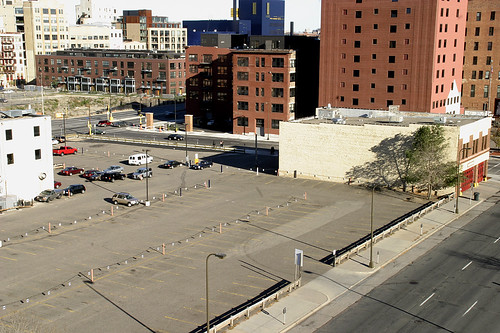 |
| Surface Parking Lot, Minneapolis, MN Originally uploaded by Zach K |
| When the parking tail wags the use dog: Some large surface parking lots in Downtown, Minneapolis (but not at the brewery.) |
Far too often, thoughtless minimum parking requirements drive development decisions, to the detriment of just about everyone — a theme best developed by UCLA’s Don Shoup in his terrific book, The High Cost of Free Parking. Another story, as both data point and lesson:
Our favorite local micro-brewery gives tours; we went last Friday evening, where we heard this story.
The brewer’s parents owned and ran for many years a small industrial abrasives plant in a first-ring Minneapolis suburb. After running a hobby brewery in one corner of the factory, the brewer proposed to his parents: “Our sales are declining; the future for small industrial abrasives plants isn’t what it used to be. I’d like to turn the building into a brewery.” With their OK, he set out to get permits.
The prospective brewer/owner wrote a long proposal to the city addressing why the brewery would be a) good for the city, and b) not cause problems with water demand, electricity demand, sewage, odors, traffic — you name it.
“I was,” he said, “prepared for just about any question I could imagine.”
At the City Council meeting, the assembled counselors leafed through the proposal. Then one leaned into the mic: “This is all fine. But what about parking?” As the brewer tells the story: “I had learned everything I could about odors. But parking hadn’t crossed my mind.”
Fortunately, he had an advocate on the council who suggested “Let’s cross that bridge if this becomes as successful as he hopes.”
Zoning change and permit approved.
On the night he told this story to us, the tour had in fact filled the parking lot to overflowing. The brewery doesn’t run a pub or a restaurant. Their six employees don’t take up much parking space; several ride their bikes, giving the lie to the idea that no one rides a bike to a job in an industrial zone. But most Fridays, they give tours that far, far outstrip their meager on-site parking. So, people park along the side of the industrial-park-width streets and in the lots of the neighboring plants. “We give ’em beer”, explains the brewer, by way of compensation.
Now imagine the counter-factual:
The city follows standard, recommended practice, and demands that an aspiring brewer provide enough on-site parking to accommodate peak yearly demand — those 52 days a year with tours. The abrasives plant is hemmed in; even if the aspiring brewer had money for a new parking lot, which he does not, there is no place to put it. The plant closes; it becomes another statistic of industrial decline. The tax base shrinks. There is only bad beer. People become surly.
The standard disclaimers to this kind of economic story apply. Nonetheless, I find it a wonderful story of how flexibility on a point — parking — on which flexibility is so rarely granted, a) allowed a real success, and b) spawned an efficient market-based solution.
(Although I’d love to give the brewery the the credit, name withheld in case trading beer for Friday evening parking isn’t 100% legal for some reason.)